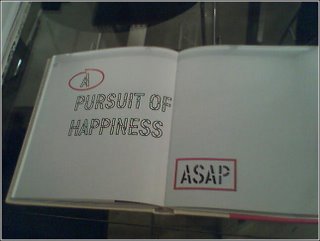 I spent most of last weekend Baseling in Miami. It was all whirlwind, heat, and flash. I’m not the first to say that art fairs are less than ideal places to see art. What follows is a list of various major trends in contemporary art that I witness in Miami. Many are of no surprise to those frequenting galleries in New York and elsewhere.
I spent most of last weekend Baseling in Miami. It was all whirlwind, heat, and flash. I’m not the first to say that art fairs are less than ideal places to see art. What follows is a list of various major trends in contemporary art that I witness in Miami. Many are of no surprise to those frequenting galleries in New York and elsewhere.Weird children’s book illustration, after Marcel Dzama. Lots of strange human–animal hybrids occupying wide expanses of blank paper or monochrome canvas. This is easily the most prevalent type of contemporary art today.
Cartoon and doodling. Think R. Crumb and Daniel Johnston. Johnston was well represented at the satellite fairs.
 Faux-naïf old-master painting and photography. Competent and occasionally excellent painting that mimics Renaissance and Baroque portraiture and history painting. Brody Condon’s digital video/video game, DefaultProperties();, at Virgil de Voldère was a highlight.
Faux-naïf old-master painting and photography. Competent and occasionally excellent painting that mimics Renaissance and Baroque portraiture and history painting. Brody Condon’s digital video/video game, DefaultProperties();, at Virgil de Voldère was a highlight.Construction art. Art that uses plywood, 2 x 4s, sheetrock, and other home-improvement-center construction materials. I discovered today that Tyler Green has called these kinds of artists Wal-Martists.
Collages with magazine pages. More sophisticated than your average high school student cutting up issues of Seventeen and Jane.
Abstract painting and drawing with dots and cells. Comes in all shapes and sizes.
Masks. On people in drawings, paintings, etc.
Solitary figures, usually women, lying comatose in natural and urban landscapes as well as interiors. Mostly in photography but also in drawing and painting.
Sex and nudity. Plenty of naked women, of course, but there’s a rise of cheerful, smiling men—sometimes naked, sometimes not—in magazinelike poses. It’s more JC Penney catalogues than Tom of Finland.
Anime. Still very much prevalent, but this needs to go away.
Work incorporating text or the creation of books. This excludes artist’s books but includes virtually all other medua. I love text-based work, so I hope this trend lives forever.
 Popular music. Sculptures of musical instruments, imagery of rock stars and cult musicians (Sun Ra, Jim Morrison, etc.), and use of recorded material (record players, records) or depictions or constructions of it.
Popular music. Sculptures of musical instruments, imagery of rock stars and cult musicians (Sun Ra, Jim Morrison, etc.), and use of recorded material (record players, records) or depictions or constructions of it.Neon. A fair amount of it in Miami. The two best works in this category played with this medium’s conventions. David Erser of Seventeen Gallery in London created a fake neon sign that says “Let’s Get It On” not in contained noble gas but rather carved from balsa wood. Erser also makes popular-music art, creating keyboards and stands made from the same wood. Ryan Gander, whom I’ve written about before, contributed one to the Annet Gelink Galerie at Basel that originally read “A Phantom of Appopriation” before the glass was smashed and fell to the floor. With Dan Graham and others, Gander participated in a panel at Basel called “Architecture for Art: Artists Who Build,” which I did not realize took place until the next day.
Low-tech, high-concept art using mechanical elements. Several notable examples: Zilvinas Kempinas, Flying Tape, 2006. And Urs Fischer’s floating Camel cigarette package. (Links are to grammar.police’s video footage.) Other works: a rising and falling house of playing cards at Dam Stuhltrager (I forget the artist’s name) and another artist at Steven Wolf Fine Art, who made a small floor sculpture mainly with Styrofoam with a bubbling, gurgling Styrofoam-ball pond.
 Lawrence Weiner . Lots of his stuff was around, especially at the convention center. This prevalance can easily be traced to the artist’s work prominently on view at the Wolfsonian Museum in Miami Beach.
Lawrence Weiner . Lots of his stuff was around, especially at the convention center. This prevalance can easily be traced to the artist’s work prominently on view at the Wolfsonian Museum in Miami Beach.TRENDS ON THE WAY OUT
Sewing. In its myriad forms, including cross-stitch, sewing on canvas.
German photography of the Becher school. Though there were plenty of Thomas Ruff’s manipulated images of internet porn. I’ve seen more of Becher school photographs on the secondary market than I ever did in the galleries.
ON THE RISE
Lenticular prints. Not much at the fairs, and the few I saw were unimpressive. But I’d like to see more artists exploit this vernacular medium.
 Other highlights: Sarah Hobb’s Periodic Table of Traits, a kind of diary art and romantic conceptualism explored by two other favorite artists of mine, Beth Campbell and Stephanie Brooks. Her work is shown at Solomon Projects in Atlanta.
Other highlights: Sarah Hobb’s Periodic Table of Traits, a kind of diary art and romantic conceptualism explored by two other favorite artists of mine, Beth Campbell and Stephanie Brooks. Her work is shown at Solomon Projects in Atlanta.

No comments:
Post a Comment